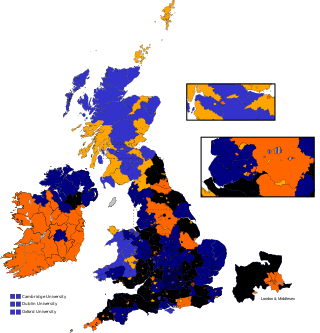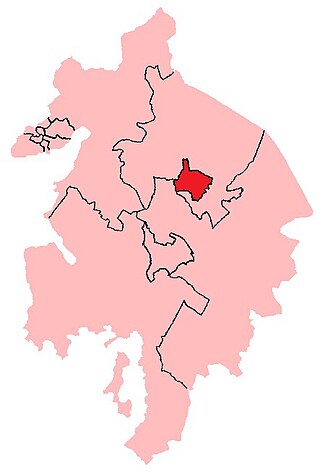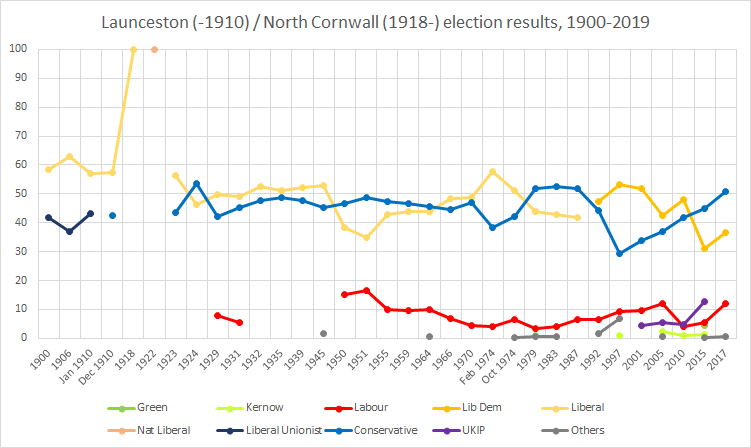
Stafford is a constituency represented in the House of Commons of the UK Parliament since 2024 by Leigh Ingham from the Labour Party.
Warwick was a parliamentary borough consisting of the town of Warwick, within the larger Warwickshire constituency of England. It returned two Members of Parliament (MPs) to the House of Commons of England from 1295 to 1707, to the House of Commons of Great Britain from 1707 to 1800, and then to the House of Commons of the Parliament of the United Kingdom until 1885.
Newport was a rotten borough situated in Cornwall. It is now the suburb of Newport within the town of Launceston, which was itself also a parliamentary borough at the same period. It is also referred to as Newport iuxta Launceston, to distinguish it from other constituencies named Newport.

Abingdon was a parliamentary constituency in England, represented in the House of Commons of the Parliament of England until 1707, then of the Parliament of Great Britain from 1707 to 1800 and of the Parliament of the United Kingdom from 1801 to 1885. It elected one Member of Parliament (MP) from 1558 until 1983, making it one of the few English constituencies in the unreformed House of Commons to elect only one Member of Parliament (MP) by the first past the post system of election.
Morpeth was a constituency centred on the town of Morpeth in Northumberland represented in the House of Commons of the Parliament of England from 1553 to 1707, the Parliament of Great Britain from 1707 to 1800, and then the Parliament of the United Kingdom from 1800 to 1983.

Tiverton was a constituency located in Tiverton in east Devon, formerly represented in the House of Commons of the Parliament of the United Kingdom. Enfranchised as a parliamentary borough in 1615 and first represented in 1621, it elected two Members of Parliament (MPs) by the first past the post system of election until 1885. The name was then transferred to a county constituency electing one MP.
Ashburton was a borough constituency represented in the House of Commons of the Parliament at Westminster, for the Parliaments of 1295 and 1407, and regularly from 1640 until it was abolished for the 1868 general election. It was one of three Devon borough constituencies newly enfranchised in the Long Parliament. It returned two Members of Parliament until the 1832 general election when the number was reduced to one MP.
Hythe was a constituency centred on the town of Hythe in Kent. It returned two Members of Parliament to the House of Commons until 1832, when its representation was reduced to one member. The constituency was abolished for the 1950 general election, and replaced with the new Folkestone and Hythe constituency.
Chatham was a parliamentary constituency in Kent which returned one Member of Parliament (MP) to the House of Commons of the Parliament of the United Kingdom. It was created for the 1832 general election, when the borough of Chatham was enfranchised under the Reform Act 1832.
Rye was a parliamentary constituency centred on the town of Rye in East Sussex. It returned two Members of Parliament to the Parliament of England before 1707, Parliament of Great Britain until 1801 and the House of Commons of the Parliament of the United Kingdom until its representation was halved under the Reform Act 1832.
Northallerton was a parliamentary borough in the North Riding of Yorkshire, represented by two Members of Parliament in the House of Commons briefly in the 13th century and again from 1640 to 1832, and by one member from 1832 until 1885.

East Cornwall was a county constituency in the House of Commons of the Parliament of the United Kingdom. It elected two Members of Parliament (MPs) by the bloc vote system of election.

West Cornwall was a county constituency in the House of Commons of the Parliament of the United Kingdom. It elected two Members of Parliament (MPs) by the bloc vote system of election.

Coventry was a borough constituency which was represented in the House of Commons of England and its successors, the House of Commons of Great Britain and the House of Commons of the United Kingdom.
Haverfordwest was a parliamentary constituency. It returned one Member of Parliament (MP) to the House of Commons of the Parliament of the United Kingdom, elected by the first past the post system.
Newcastle-upon-Tyne was a parliamentary borough in the county of Northumberland of the House of Commons of England from 1283 to 1706, then of the House of Commons of Great Britain from 1707 to 1800 and of the House of Commons of the United Kingdom from 1801 to 1918. It returned two Members of Parliament (MPs), elected by the bloc vote system.
Andover was the name of a constituency of the House of Commons of the Parliament of England from 1295 to 1307, and again from 1586, then of the Parliament of Great Britain from 1707 to 1800 and of the Parliament of the United Kingdom from 1801 to 1918. It was a parliamentary borough in Hampshire, represented by two Members of Parliament until 1868, and by one member from 1868 to 1885. The name was then transferred to a county constituency electing one MP from 1885 until 1918.
Boston was a parliamentary borough in Lincolnshire, which elected two Members of Parliament (MPs) to the House of Commons from 1547 until 1885, and then one member from 1885 until 1918, when the constituency was abolished.
Wilton was the name of a parliamentary borough in Wiltshire. It was represented in the House of Commons of the Parliament of England from 1295 to 1707, then in the Parliament of Great Britain from 1707 to 1800 and finally in the House of Commons of the United Kingdom of the Parliament of the United Kingdom from 1801 to 1918. It had two Members of Parliament (MPs) until 1832, but from 1832 to 1885 only one member, as a result of the Reform Act 1832 where it also absorbed the former rotten borough of Old Sarum. In 1885 the borough was abolished, but the name of the constituency was then transferred to a new county constituency electing one Member from 1885 until 1918.

Monmouthshire is a constituency of the House of Commons in the UK Parliament, and was first contested at the 2024 general election, following the 2023 Periodic Review of Westminster constituencies. Its current MP is Catherine Fookes, a member of the Labour.









